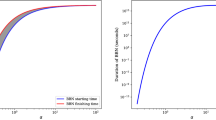Abstract
If all the fundamental constants x of physics were expressed in one set of units (e.g., mks) and then used as pure numbers in one overall histogram, what shape would that histogram have? Based on some invariances that the law should reasonably obey, we show that it should have either an x−1 or an x−2 dependence. Empirical evidence consisting of the presently known constants is consistent with an x−1 law. This is independent of the system of units chosen for the constants. The existence of the law suggests that the fundamental constants may have been independently and randomly chosen, at creation, from it, and hence that at the next “big bang” randomly a different set will be produced. Also, because of the law, the number 1.0 has an interesting cosmological property: it is the theoretical median of all the fundamental constants. Finally, as a practical matter, the law predicts that current methods of evaluating the fundamental constants are biased toward overly large numbers. A correction term is given for each of three kinds of noise.
Similar content being viewed by others
References
C. W. Allen,Astrophysical Quantities (Athlone Press, London, 1973), 2nd edn.
H. H. Jeffreys,Scientific Inference (Cambridge University Press, London, 1973), 3rd ed.
E. T. Jaynes, “Prior Probabilities”,IEEE Trans. Syst. Sci. Cybern. SSC-4, 227–241 (1968).
A. Papoulis,Probability, Random Variables and Stochastic Processes (McGraw-Hill, New York, 1965).
B. R. Frieden,Probability, Statistical Optics and Data Testing (Springer-Verlag, New York, 1983).
B. R. Frieden, “Unified Theory for Estimating Frequency-of-Occurrence Laws and Optical Objects,”J. Opt. Soc. Am. 73, 927–938 (1983).
Private communication, John Morgan, Aerospace Corporation, Los Angeles.
C. E. Shannon, “A mathematical Theory of Communication,”Bell Syst. Tech. J. 27, 379–423, 623–656 (1948).
P. A. M. Dirac, “A New Basis for Cosmology,”Proc. R. Soc. London Ser. A 165, 199–208 (1938).
F. J. Dyson, “The Fundamental Constants and Their Time Variation,” inAspects of Quantum Theory, A. Salam and E. P. Wigner, eds. (Cambridge University Press, Cambridge, 1972).
H. H. Jeffreys,Theory of Probability (Oxford University Press, London, 1961), 3rd. edn.
R. S. Pinkham, “On the Distribution of First Significant Digits,”Ann. Math. Stat. 32, 1223–1230 (1961).
B. H. Soffer, Hughes Research Laboratories, private communication.
E. T. Jaynes, “The Well-Posed Problem,”Found Phys. 3, 477–492 (1973).
Y. Tikochinsky, N. Z. Tishby, and R. D. Levine, “Consistent Inference of Probabilities for Reproducible Experiments,”Phys. Rev. Lett. 52, 1357–1360 (1984).
J. D. Barrow, in “Anthropic Definitions,”Q. J. R. Astron. Soc. 24, 146–153 (1983).
B. B. Mandelbrot,The Fractal Geometry of Nature (W. H. Freeman, San Francisco, 1982).
E. R. Cohen, J. W. M. Dumond, T. W. Layton, and J. S. Rollett, “Analysis of Variance of the 1952 Data on the Atomic Constants and a New Adjustment, 1955,”Rev. Mod. Phys. 27, 364 (1955).
E. Hille,Analytic Function Theory, Vol. 1 (Ginn and Company, Boston, 1959).
Author information
Authors and Affiliations
Rights and permissions
About this article
Cite this article
Frieden, B.R. A probability law for the fundamental constants. Found Phys 16, 883–903 (1986). https://doi.org/10.1007/BF00765336
Received:
Revised:
Issue Date:
DOI: https://doi.org/10.1007/BF00765336




